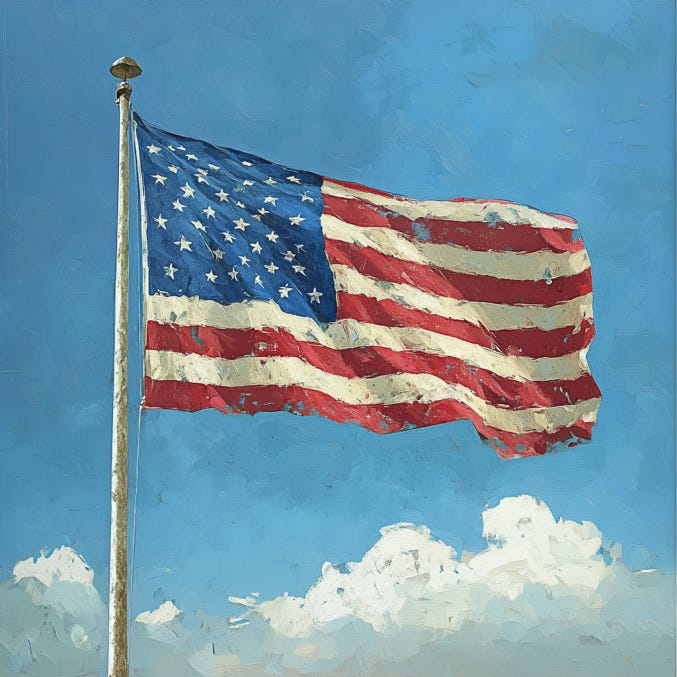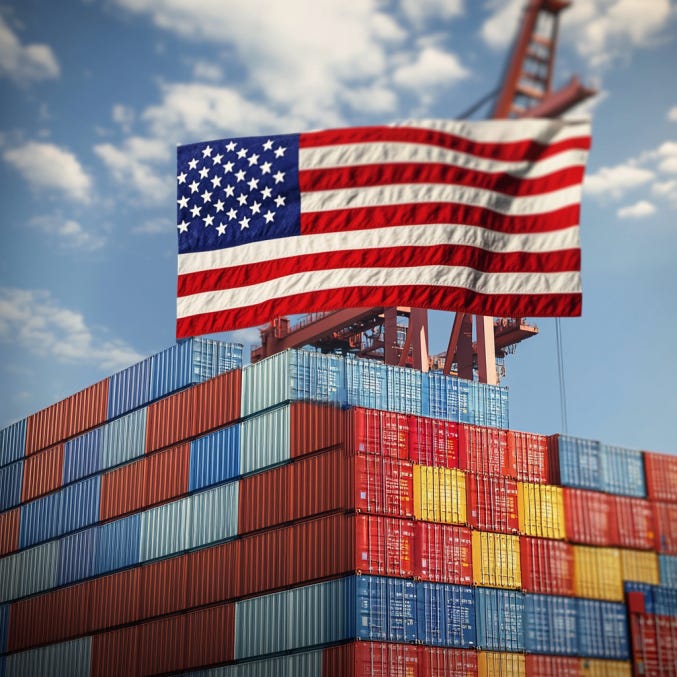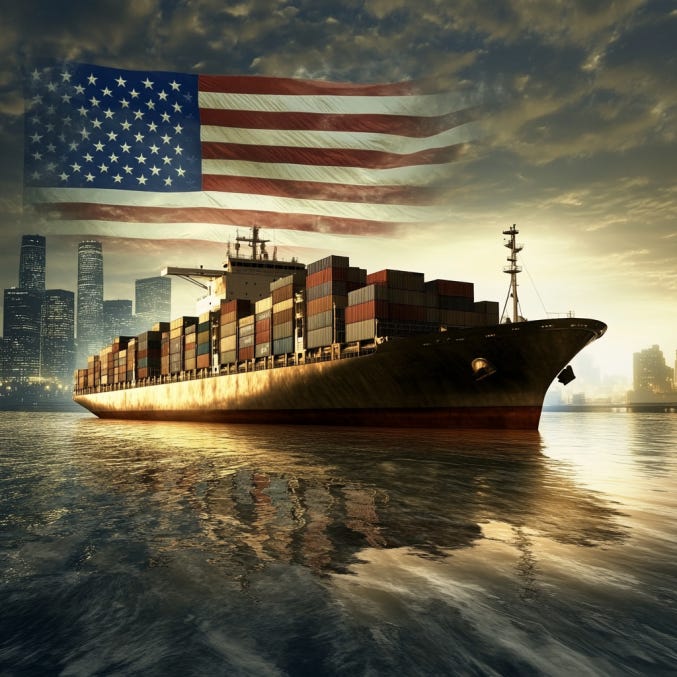U.S. Tariffs: Pros & Cons (Strategic Leverage vs. Inflation) - A Balanced, Nuanced Analysis
A balanced take on U.S. tariffs... not just mainstream economists screaming "inflation" into the void
Tariffs have long been viewed as blunt, often counterproductive instruments in the global trade arena—so much so that mainstream economic thinking typically dismisses them as little more than self-inflicted wounds on the imposing nation.
They raise consumer prices, trigger retaliation, and distort markets, or so the standard argument goes.
Yet this perspective, while not entirely wrong, overlooks why tariffs remain a go-to weapon for many political leaders, particularly in a world rife with geopolitical jockeying and fraught supply chains.
Beneath the surface, tariffs can serve as powerful bargaining chips, especially for a market as large and indispensable as the United States.
In some cases, the near-term pain of higher prices and disrupted trade flows might be worth the leverage gained—whether it’s to pressure rival economies into fairer trade practices, safeguard critical industries, or strengthen national security.
I want more people to actually think critically about both sides of the tariff coin with nuance - not just parrot what they read in some hyper-partisan news article from a “leading group of economists” or Twitter thread.
Tariffs: The Standard Economic Take vs. The Overlooked Realities
Economists traditionally argue that tariffs:
Raise Prices: Imported goods become more expensive; this cost is often passed along to American consumers.
Trigger Retaliation: Other countries impose counter-tariffs, hurting U.S. exporters and potentially leading to a trade war spiral.
Distort Resource Allocation: By shielding domestic industries from global competition, tariffs can lead to inefficiency and complacency.
These concerns are legitimate. There is a clear link between higher trade barriers and consumer price inflation in the tariff-imposing country, especially in the short to medium term.
But that’s generally where economists stop… they fixate on these immediate disruptions without deeply exploring the potential long-term strategic or geopolitical benefits.
When Tariffs Can Actually Be Strategic
A.) Negotiating Leverage Over Unfair Trade Partners
If a major trading partner has restrictive market practices, currency manipulation, or forced technology transfer requirements (e.g., China), tariffs can be used as a blunt bargaining chip.
A short-term spike in inflation might be tolerable if it compels the other side to capitulate on issues like intellectual property protection, reduced subsidies for favored industries, or currency reforms.
Economists’ Blind Spot: They rarely acknowledge that political and strategic motivations can sometimes outweigh the near-term cost of higher prices. They talk as if everything can be neatly solved by the “free market” while ignoring real-world power asymmetries and negotiation tactics.
B.) Protecting Critical Industries & Supply Chains
Pharmaceuticals, semiconductors, defense tech—these are sectors too critical to rely purely on global supply chains.
Tariffs, combined with industrial policy incentives, can jump-start domestic production, ultimately reducing dependence on hostile or unreliable nations.
Critics point to “inefficiency,” but the national security and long-term stability benefits can dwarf short-term costs.
Economists’ Blind Spot: They often treat national security or resilience as intangible externalities, not factoring in the catastrophic cost if foreign supply is cut off.
C.) The U.S. Consumer Market as a Weapon
The U.S. remains the largest, wealthiest consumer market on Earth. Foreign nations and exporters cannot afford to lose it.
Tariffs exploit this leverage: “If you want access to the U.S. consumer, you play by fair rules—or face tariffs.”
Contrary to the notion that “tariffs hurt the imposer,” in reality, if the market is indispensable, foreign companies often absorb some of the costs or pass them on to their own workers in order to stay competitive.
Economists’ Blind Spot: They assume a textbook world in which all countries have equal bargaining power. But in reality, if a small- or medium-sized economy starts a tariff war with the U.S., it is far more vulnerable to market loss than the U.S. is to the loss of that country’s exports.
Why Economists Often Present an Incomplete Picture re: Tariffs…
Some of this is just due to their political leanings/preferences and a disdain for Trump, but for most its a combination of personal political tilt coupled with a focus on the legitimate downsides (e.g. inflation)… so they go hard in the paint against Republican tariffs.
1. Short-Termism in Economic Models
Mainstream models overemphasize immediate price distortions and efficiency losses, because that’s what can be measured in quarters or a few years.
But multiyear or multidecade shifts (like building domestic industries, establishing new supply lines, or forcing reforms in foreign markets) aren’t as easily modeled. Economists tend to sidestep these complexities or reduce them to footnotes.
2. Globalist Interests (America Second)
Many economists operate from a global welfare perspective—which is fine academically—but can clash with national priorities.
When the U.S. imposes tariffs, it might harm global welfare in the short run yet enhance U.S. strategic positioning or force critical reforms abroad that ultimately benefit the U.S. (and maybe even the global system) in the long run.
3. Lobbyist and Financial Sector Influence
The banking, retail, and investment sectors loathe tariffs because they disrupt supply chains, hurt quarterly earnings, and spook investors.
Media outlets frequently highlight these short-term “doom and gloom” narratives—not because they are false, but because the long-term, big-picture view doesn’t serve immediate profit interests.
4. Ignoring the Leverage Factor
If tariffs truly only harmed the U.S., other countries would be ecstatic and wouldn’t retaliate.
The fact that they do retaliate indicates they genuinely feel the pressure—and that the U.S. market is a powerful trump card. Economists rarely reconcile this apparent contradiction in their “tariffs hurt the imposer” mantra.
Tariffs Can Backfire: This is True (Nobody Smart Denies This)
To be intellectually honest and maintain a balanced perspective, it’s crucial to acknowledge the risks:
Escalation & Trade Wars: If major blocs (like the EU or China) decide to endure pain and counter-tariff, it can spiral, harming both economies.
Inflationary Pressure: Consumers will feel the pinch if imported necessities spike in price. Political backlash can derail long-term plans if inflation gets too high.
Domestic Complacency: Over-protection can breed inefficiency. If U.S. industries become reliant on tariffs instead of innovation, they risk lagging behind in a rapidly evolving global market.
International Relations Strain: Excessive tariff use can alienate allies, leading to diplomatic or strategic fallout. Even close partners (EU, UK, Canada) may see the U.S. as an unreliable or bullying market.
Partisan Hypocrisy: The Trump-Biden Tariff Continuum
A.) Trump’s 2018 Tariffs
Introduced with great fanfare and fierce criticism from left-leaning media and economists.
The narrative was that Trump’s approach would destroy the economy and trigger a global trade war.
B.) Biden’s Continuation & Expansion
Biden kept most of Trump’s tariffs on Chinese goods and increased them on items like EV components, solar cells, and semiconductors.
Media outrage? Almost nonexistent. Suddenly, these tariffs were quietly accepted, despite being even more aggressive in some areas.
C.) Exposing Partisan Bias
If tariffs were “catastrophically bad” under Trump, why is the silence so deafening under Biden when he maintains or expands them?
This glaring double standard suggests that the supposed economic principle (“Tariffs are always bad”) is malleable depending on who’s in office.
RELATED: Economists Hate Trump Tariffs, Mostly Chill with Biden’s
The U.S. Leverage: Why Tariffs Aren’t Always Self-Destructive
1.) World’s Largest Consumer Market
Foreign countries have a vested interest in selling to U.S. consumers. Losing American market access can be devastating to their domestic industries.
This dynamic flips the standard economic premise on its head: Yes, Americans pay higher prices in the short term, but foreign producers risk losing an indispensable source of revenue.
2.) Potential for Self-Sufficiency
If the U.S. invests heavily in domestic manufacturing, advanced automation, and infrastructure, it may reduce its reliance on imports. Over time, that can curb the inflationary impact of tariffs and strengthen U.S. resilience.
3.) Global Power Dynamics
Tariffs can be a soft power tool: “Reform your practices or we’ll keep the tariffs.” Whether it’s IP theft, currency games, or lopsided trade agreements, the U.S. can and often does force changes—particularly when dealing with smaller economies.
Will Tariffs Work for the U.S. Long-Term? The Uncertainties
There are a series of new tariffs proposed by Trump for 2025… it remains unclear how effective these will be for enhancing the U.S. strength long-term.
Political Will & Voter Tolerance
Tariffs cannot endure if the public backlash over price hikes becomes overwhelming.
Lobbyists, big retail, and consumer advocacy groups can derail policy if inflation hits home too hard.
Timelines for Domestic Industry
Building robust domestic supply chains is a multi-year or even multi-decade endeavor. Politicians prefer quick wins. That tension can undermine a tariff strategy before it yields results.
Risk of Global Isolation
If the U.S. imposes punitive tariffs on allies (e.g., EU, Canada), it risks fracturing essential diplomatic alliances, which could have security and geopolitical consequences well beyond trade.
Other Economies Aren’t Helpless
The EU and China are not minor players. They can retaliate via different levers (supply chain bans, restrictions on technology components, forming alternative trade blocs) that might hurt the U.S. in unexpected ways.
RELATED: A Hypothetical “America First” Reciprocity Act (2025)
Final “Balanced Take” on Tariffs…
Tariffs Are a Double-Edged Sword
Yes, they are often inflationary and can lead to short-term pain.
Yes, they can be strategically useful for reshaping unfair trade conditions, defending key industries, and leveraging the U.S. consumer market.
Economists’ Partial Truth
They’re not wrong about the inflationary impact—but they too frequently ignore or discount the power dynamics and long-term strategic outcomes that tariffs can influence.
U.S. Leverage Is Real
Because the U.S. market is so critical, foreign partners fear losing access—hence why they retaliate instead of thanking us for “hurting ourselves.” It’s a tacit admission that the U.S. has real economic firepower.
Policy Requires Nuance
A blanket stance (“all tariffs bad” or “tariffs solve everything”) is naive. It depends on:
Which sectors? (Critical? Non-critical?)
Which partners? (Allies vs. strategic rivals)
Duration & Implementation (Permanent or temporary leverage?)
Partisan Hypocrisy Undermines Credibility
Trump was crucified for tariffs; Biden has largely continued them with minimal fuss. This reveals more about political bias than it does about consistent economic logic.
Ultimately, tariffs can be both beneficial and detrimental—it hinges on how and why they’re employed, what long-term strategy underpins them, and whether the U.S. can endure the interim inflationary pain.
The reality is that, from a U.S.-centric standpoint, a certain kind of tariff-based hardball can yield outsized results—but only if the administration has the political fortitude to bear short-term costs and the strategic vision to translate that leverage into meaningful, long-term gains.








